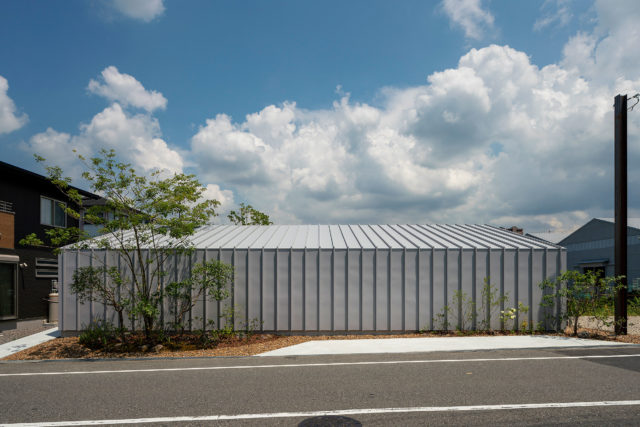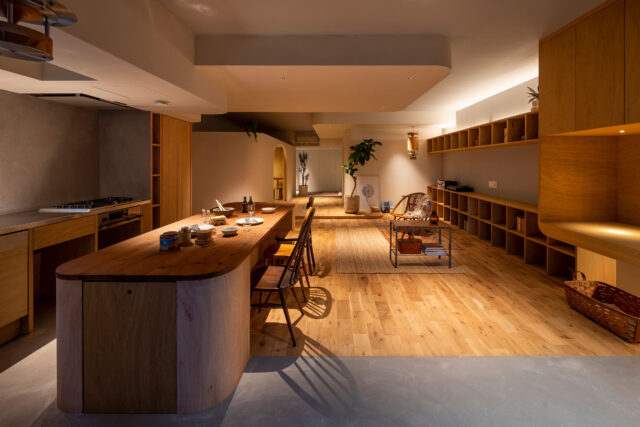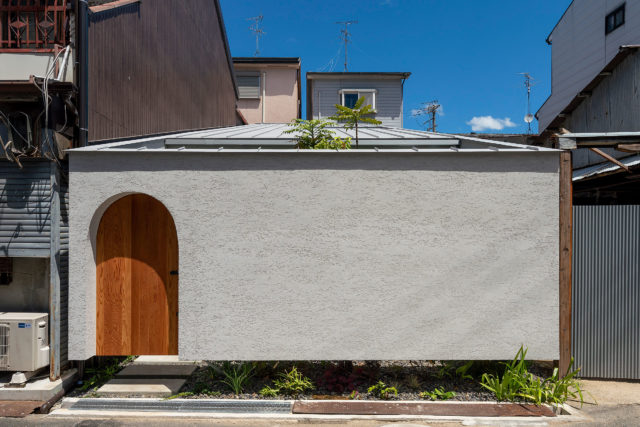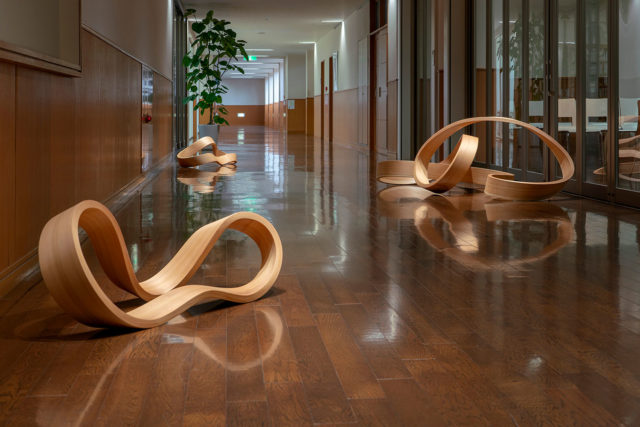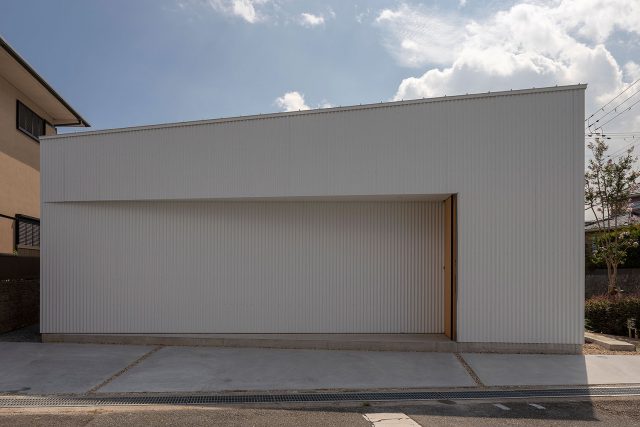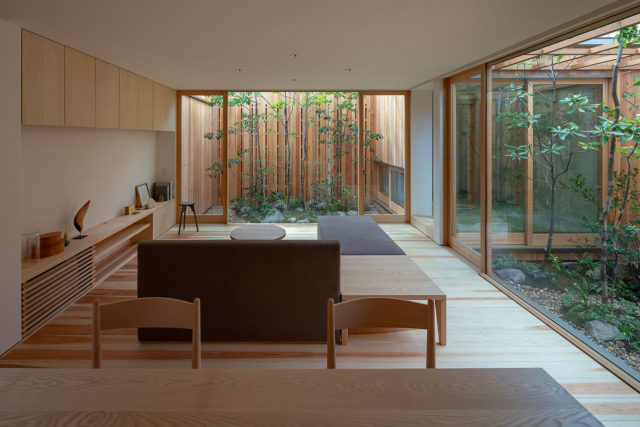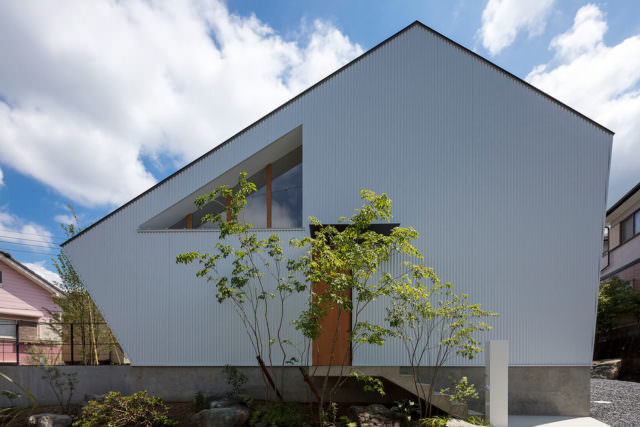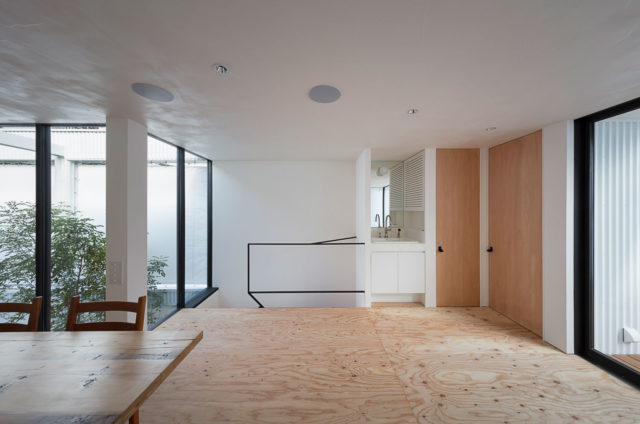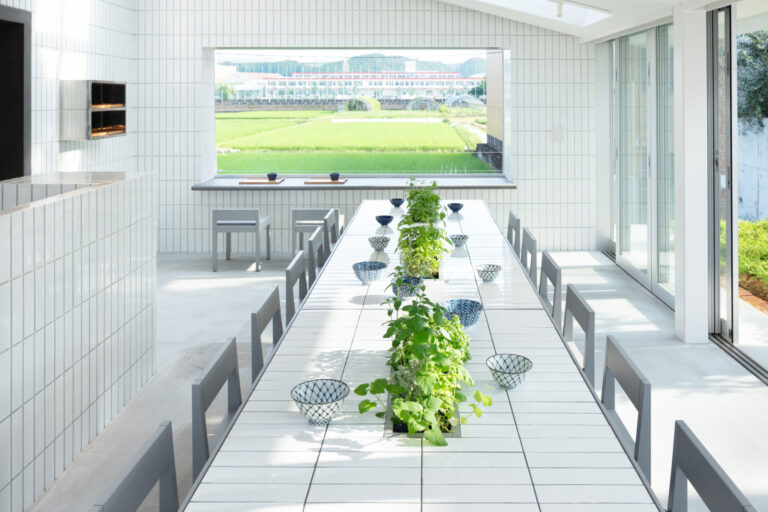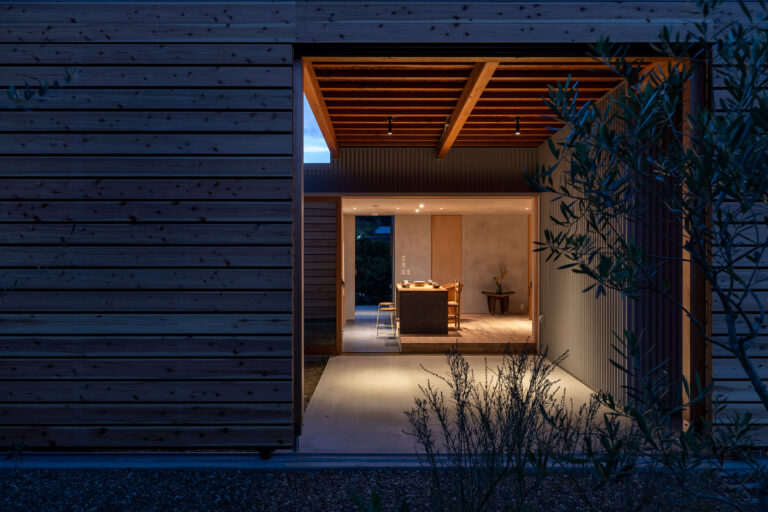
SHARE 堤庸策 / arbolによる、奈良・生駒郡の住宅「平群の家」。諸機能を兼ねる空間によって“量より質”を追求する設計を意図



堤庸策 / arbolが設計した、奈良・生駒郡の住宅「平群の家」です。諸機能を兼ねる空間によって“量より質”を追求する設計が意図されました。
家の設計の始まり。それは、施工主のご家族が増えたことがきっかけであった。
「一軒家に暮らしたい」という要望と、「好きな物に囲まれて過ごしたい」というライフスタイルから始まった。シンプルな住まいでありながら、かつ、そこに住む人間によって見える景色や彩りが変わるような住居を希望していた。また、法的な床面積も一般的な広さより小さくなることを前提に家づくりにとりかかった。
最も特徴的な要素は、何と言っても敷地の両端まである塀。
ここでの目的は、限られたコスト内でいかにプライバシー感のある空間をどう創るかであった。ただ、それでいて、時には周囲と溶け込みながら、閉塞感を緩和させるためにはどうするか?という観点にも配慮した。その結果、『プライバシー感のある空間』と『閉塞感がない空間』の双方を満たせるような堀を設計した。
お客様はコンパクトでありながらも、「質」を重視していた。昨今の世の中では、『情報過多』かつ『物質過多』の中、ミニマリズムが見直されつつある。
そのために工夫した例の一つ。それは、“玄関ポーチ 兼 アウトドアリビング”だ。ここは玄関ポーチでありながらも、ちょっとしたアウトドアも実施できる空間となっている。
以下の写真はクリックで拡大します
























以下、建築家によるテキストです。
家の設計の始まり。それは、施工主のご家族が増えたことがきっかけであった。
「一軒家に暮らしたい」という要望と、「好きな物に囲まれて過ごしたい」というライフスタイルから始まった。シンプルな住まいでありながら、かつ、そこに住む人間によって見える景色や彩りが変わるような住居を希望していた。また、法的な床面積も一般的な広さより小さくなることを前提に家づくりにとりかかった。
敷地の希望は、現在住んでいる場所からあまり離れていない所で、駅からの距離や予算的にもちょうどよい住宅地だった。
そのような流れで、上記のすべてを満たす「平群」に家を建てる運びとなった。施工主と何度もヒアリングを重ねた上で、これらの全ての要望を叶えるべく、2つのコンセプト(『平屋』『量より質』)を両立できるような設計を実施した。
『flat building ~平屋~』
最も特徴的な要素は、何と言っても敷地の両端まである塀。
ここでの目的は、限られたコスト内でいかにプライバシー感のある空間をどう創るかであった。ただ、それでいて、時には周囲と溶け込みながら、閉塞感を緩和させるためにはどうするか?という観点にも配慮した。その結果、『プライバシー感のある空間』と『閉塞感がない空間』の双方を満たせるような堀を設計した。
ただ、住宅地内に塀のみの空間では圧迫感がある。そこで、塀と建物の配置を道路平行線上からずらした。隣地の窓に対して建物を平行にしない事により、内部と外部の視線が対面的ではなくなり、ズレが気になりにくくなる。また、その結果として4つの庭が生まれ、その時折の居心地の良い場所を選択できることも、魅力の一つとなった。
さらに、動線としてリビングから繋がる各部屋には明確な玄関や、一見、一部廊下に見えるトイレ前も洗面を兼ねる設計。
家事動線も考え、玄関土間と通り土間を一体にし、勝手口とのつながりを取っている。子供部屋は将来2つの部屋になることも想定している。仕上げは、漆喰、無垢フローリングで行っている。
『quality before quantity ~量より質~』
お客様はコンパクトでありながらも、「質」を重視していた。
昨今の世の中では、『情報過多』かつ『物質過多』の中、ミニマリズムが見直されつつある。
そのために工夫した例の一つ。それは、“玄関ポーチ 兼 アウトドアリビング”だ。ここは玄関ポーチでありながらも、ちょっとしたアウトドアも実施できる空間となっている。施工主のご家族が増えたことで、活動内容も様々に変化する。“玄関ポーチ”というスペースにおいても、家族で彩り豊かな思い出を作ってほしいと願っている。
また、“クローゼット 兼 ドライスペース”という空間も同様だ。ご家族が増えると、洗濯物の量は必然と増える。クローゼットとしてだけでなく、雨の日でも部屋干しができる空間だ。
これらは、まさにQuality of Lifeを高めることができるスペースである。
換気設備は、濾過した空気を室内へ取り込むフィルターがポイントだ。
設計時の想いは、何よりも、『ご家族がいつまでも健康でいてほしい』ということ。外気の不純物を除去するフィルターを介した第2種換気を採用し、住宅の隅々までクリーンな空気の循環が生まれるようにした。また、木造用の吹き付け断熱材を使用し、サッシも複層ガラスで断熱性を高めた。
植栽計画は、シンプル且つインパクトのある塀を持つファサードに対して3本のオリーブを対峙。同一樹種を強調するため、周囲は砂利敷きとし、塀の内外の繋がりとして砂利敷きを栗石で円形状に囲んだ。内側にはオリーブに似た葉色を持つセイヨウニンジンボクを植栽し、開放時の空間の連続性を持たせた。
これらの樹が大きく育てば、この住まいのコンパクトさと贅沢さをさらに印象付けてくれることと思う。
照明計画は、物の見やすさに重きを置いた。明るさの「量」をもとめる「光量過多」を見直し、夜を心地よく暮らし、影や暗さを肯定するあかりを追求した照明計画である。天井のダウンライトは、照明が「点灯」しているのに「消灯」しているように錯覚する「グレアレスダウンライト」を採用。器具の存在が抑えられ、不快な眩しさも排除した。サイズも、Φ50と小さな照明器具を採用。
照明器具の存在が抑えられた天井面は、空間の美しさと洗練されたミニマムリズムが共存している。
大量生産・大量消費の時代はもう終わりつつある。これからは、コンパクトで好きなものだけに囲まれながらも質がよく使い勝手のよいことが求められる時代だ。先人たちの挑戦を見習いつつ、今後の住宅事情に新たな息吹、モデルとなるあり方になる事を願っている。
■建築概要
家族構成:ご夫婦+お子様3人
構造規模:木造平屋建て
建築面積:63.33㎡
一階床面積:45.61㎡
延床面積:45.61㎡
工事期間:2021年1月~2021年7月
基本設計・実施設計・現場監理:arbol
実施設計協力:宮本善州建築設計事務所
構造設計:一級建築士事務所ステラジアン
照明設計:大光電機株式会社 花井架津彦
施工:株式会社 千代田商会
造園:planta 清野陽介
サイトリサーチ・ファイナンシャルデザイン:株式会社ハウス・ブリッジ
写真:下村康典
| 種別 | 使用箇所 | 商品名(メーカー名) |
|---|---|---|
| 外装・壁 | 外壁 | |
| 内装・床 | 床 | フローリング:オスモカラー フロアクリア(オスモ&エーデル) |
| 内装・壁 | 壁 | |
| 内装・壁 | キッチン壁 | |
| 内装・壁 | 洗面室壁 | |
| 内装・天井 | 天井 |
※企業様による建材情報についてのご意見や「PR」のご相談はこちらから
※この情報は弊サイトや設計者が建材の性能等を保証するものではありません
The beginning of the design of the house.
The need for a new house was triggered by an increase in the size of the contractor’s family. It began with a desire to “live in a single house” and a lifestyle of “spending time surrounded by our favorite things”. I wanted a house that was simple, but at the same time, where the scenery and colors that users could see changed depending on the people living there. In addition, I focused on “low cost” and I searched for a house on the premise that I would not receive instructions on the floor area (construction area).
The hope for the site was that it would not be too far from the current residence, located in a residential area, and was just right regarding distance to the station and the budget.
Regarding this, it was decided that a building a house in “Heguri” would meet all the above requirements. After repeated meetings with the contractor, in order to fulfil all the requests, we landed on a design that could balance two concepts (“flat building” and “Quality before quantity”).
“Flat building”
The most distinctive element is the wall that extends to both ends of the site. The purpose was to create a space with a sense of privacy within a limited cost. However, what should we do to alleviate the feeling of obstruction while sometimes blending in with the surroundings? I also considered the viewpoint. As a result, we designed a canal that can satisfy both “a space with a sense of privacy” and “a space without a sense of obstruction”.
However, there is a sense of oppression in a space with only a fence visible in a residential area. Therefore, the layout of the fence and the building was shifted from the parallel line of the road. By not making the building parallel to the windows of the adjacent land, the lint of sight inside and outside will not be face-to-face, and the deviation is not easily noticed. The result was four gardens, and one of the charms is that one has a choice of different comfortable places.
In addition, each room connected to the living room, serving as a flow line, has a clear entrance. The front of the toilet which, at a glance, looks like part of the corridor is designed to double as a washbasin.
Considering the flow of housework, the entrance soil and street are integrated to establish a connection with the kitchen. Two children’s rooms are expected in the future. Finishing is achieved with plaster and solid flooring.
“Quality before quantity”
Low cost tends to be relatively cheap. However, while being compact, the customers emphasized “quality”. In today’s world, minimalism is being reviewed in the context of “information overload” and “material overload”. In order to keep up with such trends, we tried to make minimalism and quality coexist. In other words, the purpose is to improve “quality” while limiting “quantity”.
One of the examples devised for that purpose is the “entrance porch and outdoor living room”. Although this is the entrance porch, it is a space where one can do little outdoor activities. As the size of the family increases, the activities will change in various ways. It is my hope that the family will create colorful memories even in the space called the “entrance porch”.
The same applies to the space called the “closet and dry space”. As the number of family members increases, the amount of laundry inevitably increases. It is not only a closet, but a space where one can dry their room, even on rainy days.
These are the spaces that can enhance quality of life.
The point of ventilation equipment is a filter that takes filtered air into the room.
The idea at the time of design was, above all, “I want the family to stay healthy forever”. We adopted type 2 ventilation through a filter that removes impurities from the outside air, so that clean air circulation can be created in every corner of the house. In addition, a sprayed heat insulating material for wooden construction was used, and the sash was also made of double glazing to improve the heat insulating properties.
The planting plan is to place three olives against a simple yet impressive façade. In order to emphasize the same tree species, the surrounding area was covered by gravel, and gravel was surrounded by chestnut stones in a circular shape as a connection between the inside and the outside of the wall. A chaste tree, which has a leaf color similar to that of an olive tree, was planted on the inside the give the space continuity when opened.
If these trees grow to a large size, I think it will make the compactness and luxury of this house even more impressive.
The lighting plan emphasised the ease of viewing. It is a lighting plan that reconsiders the “excess of light”, seeks “quantity” of brightness and pursues the “quality of light” that lives comfortably at night and affirms shadows and darkness. The ceiling’s downlight uses a “glareless downlight” that gives the illusion that the lighting is “on” but “off”. The presence of equipment was suppressed, and unpleasant glare was eliminated. The size is also Φ50, which is a small lighting fixture.
The beauty of the space and the sophisticated minimalism coexist on the ceiling surface where the presence of lighting fixtures is suppressed.
The era of mass production and mass consumption is over. From now on, it will be an era where quality and ease of use are required while being compact and surrounded by only what one likes. While emulating the challenges of our predecessors, we hope that this will add new breath and become a model for the future of housing.
House in Heguri
Family structure: Couple + 3 children
Structural scale: Wooden one-storey building
Building area: 63.33m²
First floor area: 45.61m²
Total floor area: 45.61m²
Construction period: January 2021 – July 2021
Basic design / implementation design / site supervision: Arbol
Implementation Design: Miyamoto Yoshikuni Architects
Structural Design: First-class Architect Office Steradian
Lighting Design: Daiko Electric Co., Ltd. Katsuhiko Hanai
Construction: Chiyoda Shokai Co., Ltd
Landscaping: Planta Yosuke Seino
Financial Advice: House Bridge Co., Ltd.
Photo: Yasunori Shimomura

